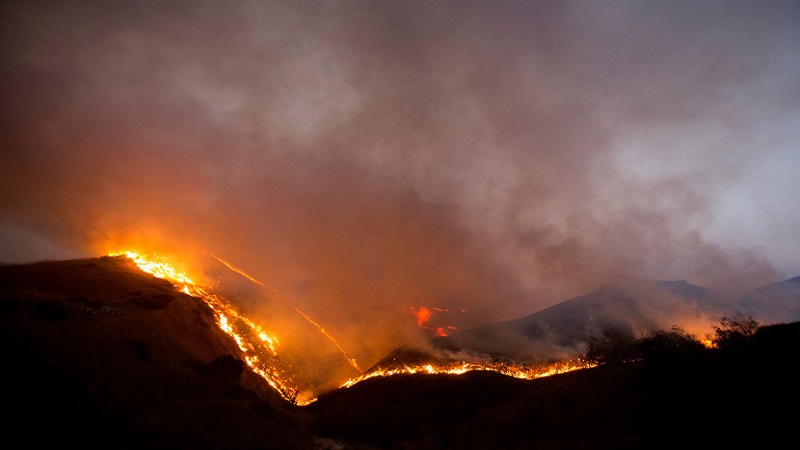Fast-spreading wildfires have forced evacuation orders for more than 100,000 people and seriously injured two firefighters in Southern California as powerful winds across the state prompted a power outage to hundreds of thousands of residents.
Some 60,000 people fled their homes near Los Angeles on Monday as the wildfire raged across more than 3,000 hectares (7,200 acres), blocking key roads in Orange County.
The so-called Silverado Fire broke out early in the morning in the foothills of Irvine, 60 kilometres (about 37 miles) southeast of Los Angeles, and quickly spread unchecked, fueled by dry conditions and erratic winds that prevented firefighting aircraft from flying.
“It’s nuts – even inside the car, my eyes, my nose and my throat stung,” said Frederic Tournadre, a French man whose company in Irvine sent all its employees home.
The inferno nearly quadrupled in size by afternoon, jumping a highway and covering the area with a huge plume of smoke and ash.
The latest threats came amid what meteorologists called the strongest onslaught of extreme winds – and lowest humidity levels – documented yet in a California wildfire season ranked as the worst on record in terms of acreage burned.
Fires have scorched more than 16,500sq km (6,400 square miles) – an area equivalent to the landmass of the state of Hawaii – since the start of the year, with thousands of homes destroyed and 31 lives lost.
Cause of the blaze
In a report to the state Public Utilities Commission, utility company Southern California Edison said it was investigating whether its electrical equipment caused the blaze. The brief report said it appeared that a “lashing wire” that tied a telecommunications line to a support cable may have struck a 12,000-volt conducting line above it, and an investigation was under way.
SCE reported shutting off electricity to 21,000 homes and businesses as a precautionary measure in the face of elevated fire risks posed by dangerous winds.
Red-flag warnings for incendiary weather conditions remained in place across much of California due to winds gusting in excess of 129km/h (80mph), according to the California Department of Forestry and Fire Protection.
Some 90,800 residents were ordered to evacuate their homes in and around the city of Irvine as the fire raged largely unchecked through drought-parched brush in the canyons and foothills of the Santa Ana Mountains south of Los Angeles, officials said.
Two firefighters among some 500 personnel battling the flames with bulldozers and hand tools were hospitalized with severe burns, authorities said.
No property losses were immediately reported.
A second Orange County blaze, the Blueridge fire, later broke out near Yorba Linda and has charred roughly 485 hectares (1,200 acres), Nguyen said. Local television news footage showed at least one home gutted by flames.
An estimated 1,170 homes were under evacuation orders from that blaze, the county fire authority said on Twitter late on Monday.
Hundreds of miles away, the Pacific Gas and Electric Company (PG&E) said it had cut off power to more than 350,000 of its customers for the same reason.
Wind-damaged electrical lines have been implicated in causing dozens of devastating California wildfires in recent years, and utilities have increasingly resorted to such “public safety power shutoffs” to reduce the risk.
Wind gusts were clocked at up to 143km/h (89mph) in Sonoma County wine country north of San Francisco Bay and were steadily blowing at more than 80km/h (50mph) elsewhere in the region.
“It’s the strongest wind event, and the lowest humidity event, for this fire season,” National Weather Service forecaster Jim Mathews told Reuters.
By midday Monday, PG&E said it was beginning to restore services to some customers “where it is safe to do so,” with most of the shutoffs expected to be ended by Tuesday night as winds abated.
The latest outbreak of fires caps a summer of record California wildfire activity stoked by increasingly frequent and prolonged bouts of extreme heat, drought, wind and dry lightning storms that scientists point to as a consequence of climate change.
Further east, in drought-stricken Colorado, an Arctic storm sweeping the Rockies over the weekend dumped 15 to 40cm (6 to 16 inches) of snow on the two largest wildfires in that state’s history.
“The snow has improved our chances of getting them contained, but we’re still a way off,” said Larry Helmerick, spokesman for the Rocky Mountain Area Coordination Center.
The two blazes combined have so far blackened well over a quarter of a million acres.
Source: Al Jazeera






 WhatsApp us
WhatsApp us 

